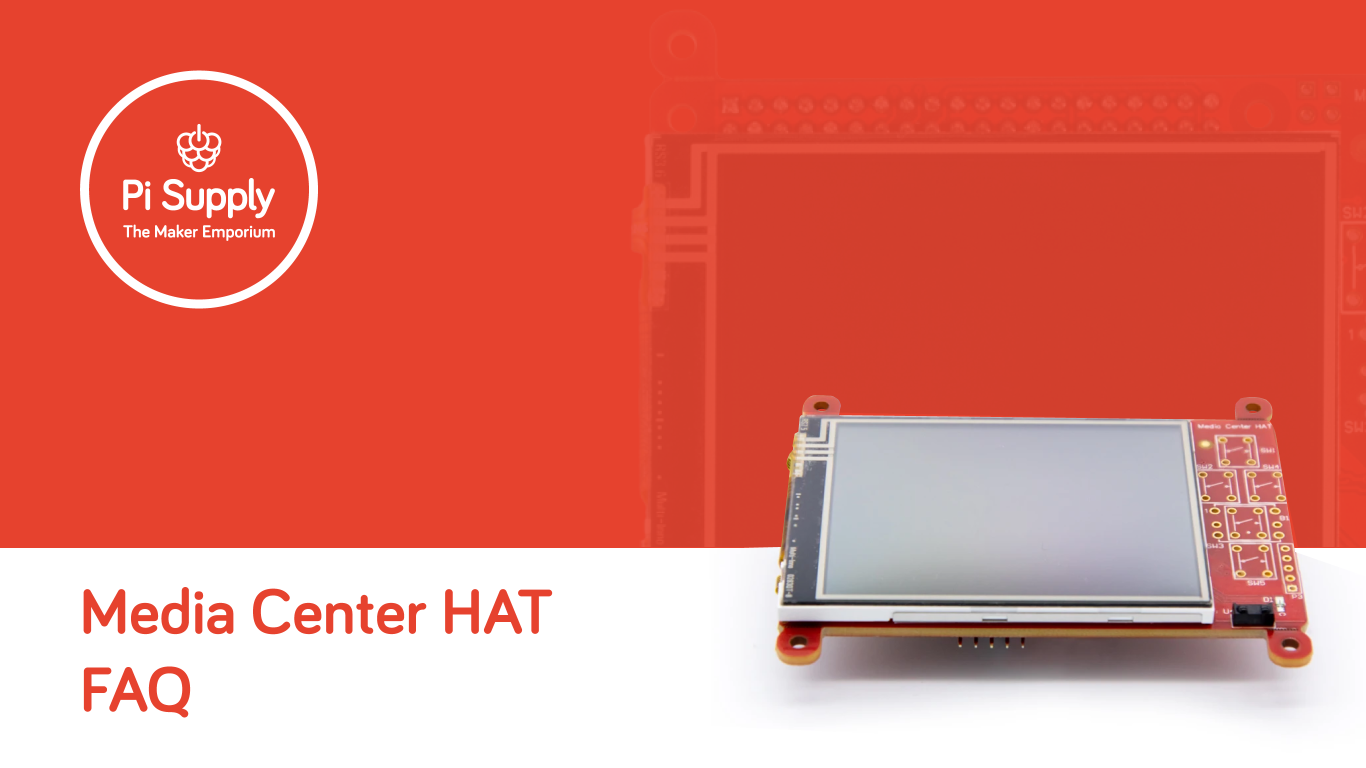
Media Center HAT FAQ
Follow the links below to access the various sections more quickly
- How to switch the console to HDMI
- How to change the console font
- How to switch the Desktop to HDMI
- How to mirror/copy the HDMI output to the display
- How to switch the backlight on/off
- Where can I find an on-screen keyboard
- Does the display work with OSMC
- Why is the display so small when I use FBCP
- I can only see the top left part of the window
- Where can I find the schematics of the Media Center HAT
- How are the tactile switches connected to the display
- How do I connect a GPIO adaptor to the display
- Can the display burn in
- Why are there lines on my screen
How to switch the console to HDMI?
Run con2fbmap 1 0 and to switch back to the display con2fbmap 1 1.
How to change the console font?
The font can be changed with console-setup or edit the file /etc/default/console-setup.
|
1
|
sudo dpkg-reconfigure console-setup |
Encoding to use on the console: <UTF-8> Character set to support: <Guess optimal character set> Font for the console: Terminus (default is VGA) Font size: 6x12 (framebuffer only)
How to switch the Desktop to HDMI?
Raspbian Buster uses lightdm to control the X server. If you haven’t used the install script then you need to edit the /etc/lightdm/lightdm.conf file and edit the comment out line:
For TFT only:
|
1
|
xserver-layout=TFT |
For HDMI only:
|
1
|
xserver-layout=HDMI |
For HDMI with TFT extended:
|
1
|
xserver-layout=HDMITFT |
How to mirror/copy the HDMI output to the display?
This program is used to copy the primary framebuffer copy to a secondary framebuffer. Usually to copy the output of the HDMI of the Raspberry Pi to a TFT display, whilst scaling down to the display output.
|
1
2
3
4
5
6
7
8
9
10
|
cd /tmpapt-get install -y git build-essential cmakegit clone --depth=1 https://github.com/tasanakorn/rpi-fbcpmkdir -p rpi-fbcp/buildcd rpi-fbcp/buildcmake ..makeinstall fbcp /usr/local/bin/fbcpcd ../..rm -r rpi-fbcp |
How to switch the backlight on/off?
The display backlight can be turned on/off and can also be dimmed (using PWM).
- backlight off:
|
1
|
echo 1 | sudo tee /sys/class/backlight/*/bl_power |
- backlight on:
|
1
|
echo 0 | sudo tee /sys/class/backlight/*/bl_power |
Where can I found an on-screen keyboard?
You can install Florence Virtual Keyboard or Matchbox Virtual Keyboard with the following commands:
|
1
|
sudo apt-get install florence |
|
1
|
sudo apt-get install matchbox-keyboard |
Does the display work with Raspbmc/OSMC?
Yes, the FBTFT framebuffer can be installed on Raspbmc/OSMC and the HDMI output can be mirrored to the display using fbcp. First you must install the following:
|
1
|
apt-get install rbp-userland-dev-osmc |
Why is the display so small when I use fbcp?
The framebuffer copies the display from the HDMI output so if the HDMI native resolution is large then it will shrink it down to the TFT display resolution 320×240. To make it more reasonable you can change the resolution by editing the /boot/config.txt file and adding the following:
|
1
2
3
4
5
|
hdmi_force_hotplug=1hdmi_group=2hdmi_mode=4 |
For a resolution of 640×480 (will be scaled to 320×240 on the display)
I only see the top left part of a program window/dialog?
Most programs are not designed for a small screen (640×480) and so you see only a part of the window. It is possible to scale the screen with fbcp, but the best practice is to create an user interface specially for the display.
Where can I find the schematics for the Media Center HAT?
https://github.com/PiSupply/Media-Center-HAT/tree/master/Hardware/Design
How are the tactile switches connected on the Media Center HAT?
Please note the the 5 way joystick is alternative to the other 4 push buttons SW1-5 and therefore is connected to the same GPIO pins on the Raspberry Pi.
- SW1 GPIO13(PI33) up
- SW2 GPIO17(PI11) left
- SW3 GPIO22(PI15) bottom
- SW4 GPIO26(PI37) right
- SW5 GPIO27(PI13) enter
- B1 5 ways joystick
How to connect the GPIO-Adapter for RPi-Display B+?
See the following guide – https://learn.pi-supply.com/make/getting-started-with-the-gpio-to-fpc-breakout-phat-for-raspberry-pi/
Can the display have ghost images / burn-in?
An image can also burn in on LCD or OLED displays, if a static image is shown for several hours. To prevent this use a screensaver or make a screen inversion after some time, e.g. a day-night operation with inverted colors. In general a white screen is also better than a black one on TFT displays, in terms of image burn-in.
Why are there lines on my screen?
LCD screens just like any electrical component are sensitive to electrostatic. The lines on the screen are a result of this electrostatic charge. It is important to handle the Media Center HAT with care and take electrostatic precautions as a result.
